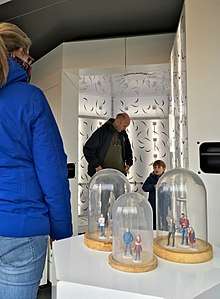3D body scanning

3D body scanning is an application[1] of various technologies such as Structured-light 3D scanner, 3D depth sensing, stereoscopic vision and others for ergonomic and anthropometric investigation of the human form as a point-cloud. The technology and practice within research has found 3D body scanning measurement extraction methodologies to be comparable to traditional anthropometric measurement techniques.[2][3]
Applications
While the technology is still developing in its application, the technology has regularly been applied[4] in the areas of:
- Adapted performance sportswear
- Garment design (e.g. underwear)
- 3D printed figurines
- 3D morphometric evaluation
- Ergonomic body measurement
- Apparel design (e.g. helmets)
- Body shape classification[5]
- Comparison of changes in body positions [6]
However, despite the potential for the technology to have an impact in made-to-measure and mass customisation of items with ergonomic properties, 3D body scanning has yet to reach an early adopter or early majority stage of innovation diffusion. This in part due to the lack of ergonomic theory relating to how to identify key landmarks on the body morphology.[7][8] The suitability of 3D Body scanning is also context dependant as the measurements taken[9] and the precision of the machine [10] are highly relative to the task in hand rather than being an absolute. Additionally, a key limitation of 3D body scanning has been the upfront cost of the equipment and the required skills by which to collect data and apply it to scientific and technical fields.
Scanning protocol
Although the process has been established for a considerable amount of time with international conferences held annually for industry and academics (e.g. the International Conference and Exhibition on 3D Body Scanning Technologies), the protocol and process of how to scan individuals is yet to be universally formalised.[11] However, earlier research [12] has proposed a standardised protocol of body scanning based on research and practice that demonstrates how non-standardised protocol and posture significantly influences body measurements;[13] including the hip.[14]
References
- ↑ Parker, C.J., Gill, S. and Hayes, S.G. (2017), “3D Body Scanning has Suitable Reliability: An Anthropometric Investigation for Garment Construction”, in D’Apuzzo, N. (Ed.), Proceedings of 3DBODY.TECH 2017 - 8th International Conference and Exhibition on 3D Body Scanning and Processing Technologies, Montreal QC, Canada, 11-12 Oct. 2017, Hometrica Consulting - Dr. Nicola D’Apuzzo, Ascona, Switzerland, pp. 298–305.
- ↑ Simmons, K.P. and Istook, C.L. (2003), 'Body measurement techniques: Comparing 3D body‐scanning and anthropometric methods for apparel applications’, Journal of Fashion Marketing and Management: An International Journal, MCB UP Ltd, Vol. 7 No. 3, pp. 306–332.
- ↑ Bougourd, J.P., Dekker, L., Grant Ross, P. and Ward, J.P. (2000), ‘A Comparison of Women’s Sizing by 3D Electronic Scanning and Traditional Anthropometry’, Journal of The Textile Institute, Vol. 91 No. 2, pp. 163–173.
- ↑ http://www.3dbodyscanning.org/cap/papers2016.html
- ↑ Stewart, A., Ledingham, R. and Williams, H. (2017), 'Variability in body size and shape of UK offshore workers: A cluster analysis approach’, Applied Ergonomics, Vol. 58 No. 1, pp. 265–272.
- ↑ Choi, S. and Ashdown, S.P. (2011), ‘3D body scan analysis of dimensional change in lower body measurements for active body positions’, Textile Research Journal, Vol. 81 No. 1, pp. 81–93.
- ↑ Gill, S. (2015), "A review of research and innovation in garment sizing, prototyping and fitting", Textile Progress, Vol. 47 No. 1, pp. 1–85.
- ↑ Gill, S., Parker, C.J., Hayes, S., Wren, P. and Panchenko, A. (2014), 'The True Height of the Waist: Explorations of automated body scanner waist definitions of the TC2 scanner’, 5th International Conference and Exhibition on 3D Body Scanning Technologies, Hometrica Consulting, Lugano, Switzerland, pp. 55–65.
- ↑ Gill, Simeon; Ahmed, Maryam; Parker, Christopher J.; Hayes, Steven G. (2017). "Not All Body Scanning Measurements Are Valid: Perspectives from Pattern Practice". 3DBODY.TECH 2017 - 8th Int. Conf. and Exh. on 3D Body Scanning and Processing Technologies: 43–52. doi:10.15221/17.043.
- ↑ Parker, Christopher J.; Gill, Simeon; Hayes, Steven G. (2017). "3D Body Scanning has Suitable Reliability: An Anthropometric Investigation for Garment Construction". 3DBODY.TECH 2017 - 8th Int. Conf. and Exh. on 3D Body Scanning and Processing Technologies: 298–305. doi:10.15221/17.298. Retrieved 30 April 2018.
- ↑ Chi, L. and Kennon, R. (2006), 'Body scanning of dynamic posture', International Journal of Clothing Science and Technology, Vol. 18 No. 3, pp. 166–178.
- ↑ Gill, Simeon; Hayes, S; Parker, Christopher J. (2016). "3D Body Scanning: Towards Shared Protocols for Data Collection" (PDF). IWAMA 2016: 6th International Workshop of Advanced Manufacturing and Automation: 281–284. doi:10.2991/iwama-16.2016.53.
- ↑ Mckinnon, L. and Istook, C.L. (2002), ‘Body scanning: The effects of subject respiration and foot positioning on the data integrity of scanned measurements’, Journal of Fashion Marketing and Management, Vol. 6 No. 2, pp. 103–121.
- ↑ Gill, Simeon; Parker, Christopher J. (2017). "Scan posture definition and hip girth measurement: the impact on clothing design and body scanning". Ergonomics. 60 (8): 1123–1136. doi:10.1080/00140139.2016.1251621.
